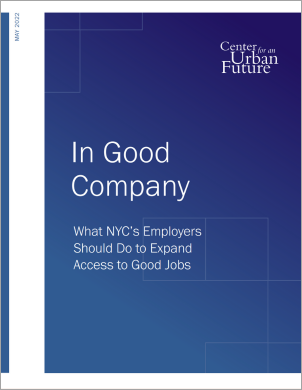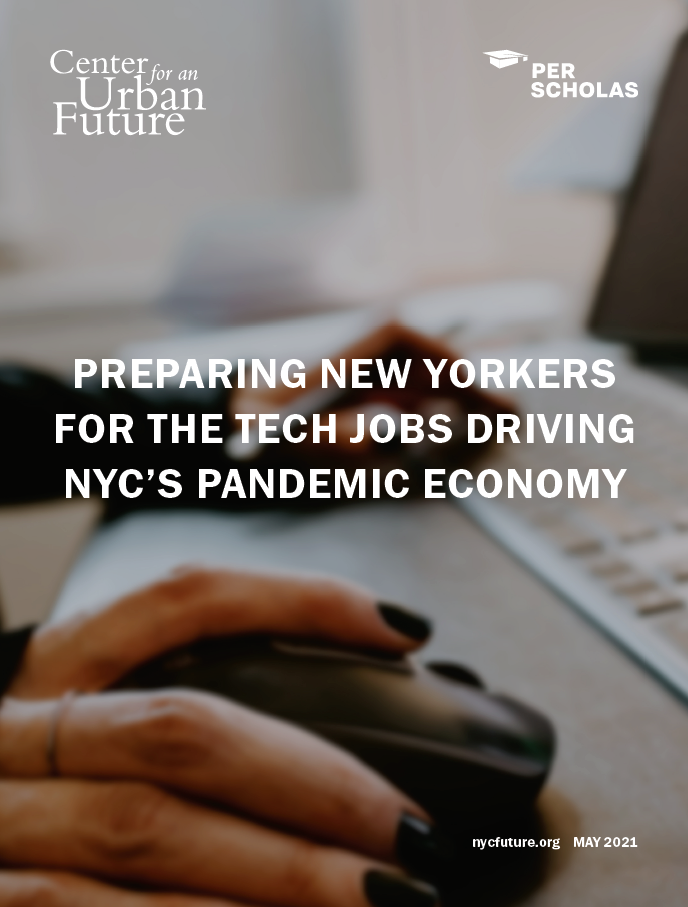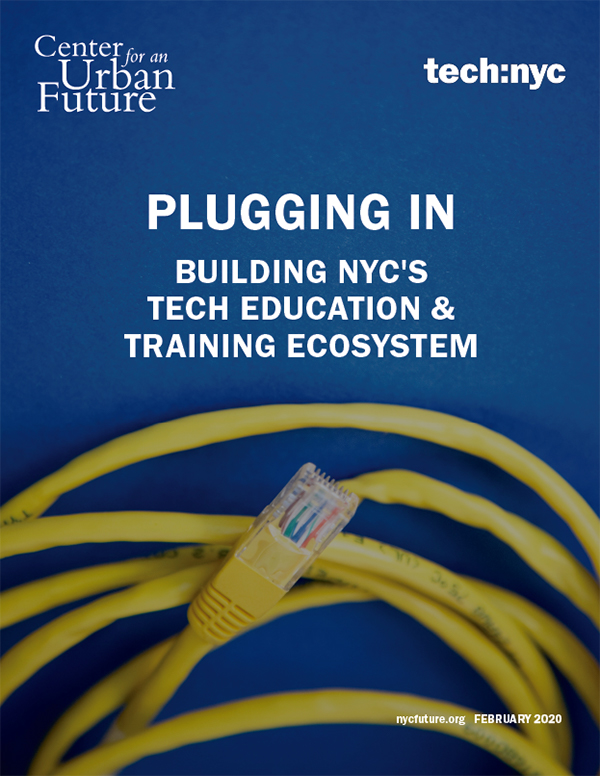- The following is the introduction and conclusion to In Good Company: What NYC’s Employers Should Do to Expand Access to Good Jobs.
- Read the full report (PDF).
Creating a more equitable economy in New York City will require bold action from Mayor Adams and the City Council, including major new investment in city programs that help expand access to the good jobs that are growing in the economy. But the private sector will also need to step up. In particular, the city’s leading employers should develop and scale up programs of their own that create far more opportunities for New Yorkers of color to gain access to the well-paying jobs that they are creating.
A growing number of New York-based employers are already taking promising steps to diversify their workforces, through changes to recruitment, hiring, and retention practices and investments in internships, apprenticeships, mentoring, and on-the-job training programs. But much more is needed. Indeed, even before the COVID-19 pandemic hit, New York City’s economy reflected stark inequalities. New Yorkers of color are alarmingly underrepresented in most of the city’s well-paying industries: For instance, Black New Yorkers make up 22 percent of the city’s workforce, but hold just 7 percent of the jobs in the securities industries, 7 percent of the positions in advertising, 8 percent in publishing and 9 percent in the tech sector.1 In nearly 100 industries, white New Yorkers out-earn Black New Yorkers by at least $10,000.2 Similar disparities persist in many industries and occupations for Hispanic New Yorkers, Asian New Yorkers, and women.
The factors that produce these disparities are complex and pervasive, likely including persistent gaps in educational attainment by race and income—magnified by the effects of systemic racism, gender bias, and ablism. But as this report shows, there are many areas where employers can and should do more to help address these inequities, close opportunity gaps, and enable far more New Yorkers from lower-income households and neighborhoods to obtain and succeed in well-paying jobs.
Today, too few companies have made progress moving beyond broader environmental, social, and governance goals and corporate statements of support to focus squarely on ways to expand access to competitive employment. Demand for paid internships in growing industries from tech and healthcare to finance and the creative economy far exceeds supply, limiting the number of New Yorkers who are able to benefit from work-based learning experiences. Likewise, New York City has seen slow growth in apprenticeship programs compared to many other cities and states, with very few new programs located in the industries that are driving the city’s economic recovery. And despite growing concerns among employers about finding talent amid a glut of unfilled job openings, relatively few employers have committed to intensive on-the-job training and upskilling programs.
Fortunately, there is no shortage of workable strategies that employers can adopt to help cultivate, hire, and retain a workforce that better reflects the diversity of New York City. This study, supported by the Gantcher Family Foundation, provides a snapshot of six innovative employer-led initiatives to expand access to good jobs—initiatives with enormous potential for replication among other companies here in New York. The report highlights what’s working about these approaches, details how each company got there, and offers specific recommendations for how employers and government leaders can work together to expand access to well-paying jobs.
This report highlights the following six strategies:
CENTERBRIDGE, a private investment management firm with more than 250 employees, is focusing its efforts to help diversify the investment industry by partnering with the City University of New York (CUNY). The firm’s CUNY Investment Industry Fellowship provides CUNY undergraduate students with monthly workshops, professional networking experiences, and mentorship opportunities—all designed to help students land highly competitive paid internships in the field. Centerbridge has since expanded the effort by recruiting other larger firms to participate, with the goal of building a pipeline from CUNY into well-paying jobs in the financial sector.
ACCENTURE, the global professional services and consulting firm, is proving that the time-tested apprenticeship model can work far beyond the building trades. The company’s apprenticeship program enables individuals outside traditional recruiting pipelines—including candidates without four-year college degrees—to develop skills while earning stable pay and ultimately to land well-paying jobs in fields such as IT, business analytics, and cybersecurity.
HORIZON MEDIA, a leading media services agency, is taking a comprehensive approach to cultivating its future workforce, combining career exploration in high schools, paid internships that lead to jobs, and an in-depth fellowship program focused on preparing people for careers in search engine optimization, programmatic media advertising, and paid search. In part as a result of these efforts, 37 percent of Horizon Media’s employees identify as a person of color, compared to an industry average of just 25 percent.
LINKEDIN, the world’s largest professional networking site, has focused on bolstering retention and advancement by building a more inclusive corporate culture. Like a growing number of companies across the country, LinkedIn is doing this in part by helping staff members establish Employee Resource Groups (ERGs), which provide staff from diverse backgrounds with inclusive community spaces to share resources. Crucially, LinkedIn has gone further and become one of a small handful of employers to provide significant compensation packages to ERG leaders, including a $10,000 annual award.
Bronx-based MONTEFIORE MEDICAL CENTER is taking a local approach to expanding access to healthcare jobs for some of the borough’s most vulnerable young adults. Through a partnership with Phipps Neighborhoods, a nonprofit social services organization, Montefiore offers out of work, out of school young adults ages 18 to 24 the opportunity to train for jobs in healthcare and earn industry-recognized credentials at Hostos Community College. The program has led to more than 200 hires at Montefiore and partner healthcare organizations, and some graduates have gone on to earn advanced postsecondary degrees that open the door to further employment opportunities.
Lastly, a growing number of employers in New York and around the world are experimenting with a shift toward skills-based hiring practices. These firms, including Google, IBM, Penguin Random House, Starbucks, and the healthcare start-up Ovia Health, are eliminating a bachelor’s degree requirement for a range of entry- and mid-level positions, and shifting toward skills-based frameworks for assessing the ability of future employees to succeed. Given the enormous disparities in bachelor’s degree attainment in New York City—just 20 percent of Hispanic New Yorkers, 27 percent of Black New Yorkers, and 45 percent of Asian New Yorkers hold a bachelor’s degree, compared to 64 percent of white New Yorkers—this shift to skills-based hiring can help open up thousands of well-paying jobs to New Yorkers who would otherwise be excluded for lack of a specific credential.3
The remainder of this report features in-depth profiles of these six employer-led initiatives to expand access to good jobs, with the goal of demonstrating to other New York–based companies that there is no shortage of attainable options for diversifying their workforces—and that emulating one of these employer-initiated models might be a good place to start. These are, of course, just a few of the many examples of companies taking concrete steps to train, hire, retain, and promote New Yorkers from underrepresented communities. For example, in 2020 more than 25 leading company CEOs pledged to hire 100,000 low-income New Yorkers, especially those from Black, Latinx, and Asian communities, in jobs that pay family-sustaining wages by 2030. These companies, operating as the New York Jobs CEO Council, are making significant investments through a nonprofit organization designed to help prepare New Yorkers for well-paying jobs at their firms in areas such as cybersecurity, project management, UX design, and data analytics. While this report focuses on the steps that New York’s employers will need to take, city government also has a vital role to play in encouraging companies to make these structural shifts, making it as easy as possible for them to do so, assessing their progress, and partnering with them when it makes sense to achieve greater scale and impact.
This report offers three priority recommendations for employers and city government leaders:
New York City’s business leaders should launch and scale up policies and initiatives that expand access to well-paying jobs in their own companies.
New York City–based companies give back to the city and their communities in numerous ways, including philanthropic grants, fundraising, and volunteering. But to help create a more inclusive and equitable economy in New York City, more businesses should implement evidence-based practices that help expand access to good jobs for residents currently underrepresented in their own workforces. These steps may include helping to co-develop a talent pipeline into their industry through career exploration, work-based learning opportunities, paid internships, and apprenticeships; establishing partnerships with CUNY, public middle and high schools, and nonprofit workforce development organizations; launching employee resource groups and rewarding staff financially for the vital work of facilitating them; expanding internal mentoring programs and measuring opportunities for promotion and advancement; and shifting toward skills-based hiring practices that can eliminate degree requirements for a growing number of career paths.
Mayor Adams should encourage and challenge businesses to do more to ensure that their workforces reflect the diversity of the city.
Mayor Adams should leverage the goodwill and political capital he’s earned from the city’s business community to encourage and challenge employers to do more to expand access to good jobs. This can be accomplished both by encouraging business leaders to adopt a range of best practices and promising models and aggressively promoting those that succeed, as well as by tracking and publicizing the share of middle- and high-wage jobs held by New Yorkers of color across industries and calling business leaders to account if those key metrics do not improve.
City leaders should make it easier for businesses both large and small to connect with local talent development pipelines.
New York City policymakers should challenge employers to do more when it comes to training, hiring, and retaining diverse talent. But that leadership should be coupled with new city efforts that make it far easier for businesses to partner with city agencies, CUNY, middle and high schools, and nonprofit workforce development organizations—and to make these programs work better for small businesses. For instance, policymakers could focus on making it easier for employers to offer paid internships by matching their openings with talented candidates from public high schools and colleges and providing wage subsidies to help smaller employers take on paid interns from less traditional backgrounds. City officials also have a role to play in growing support for apprenticeship programs, expanding technical assistance programs designed to help companies adopt new hiring practices, connecting far more employers with local schools to develop career exploration opportunities, and pooling interest among smaller employers to help them participate in existing programs like the Tech Talent Pipeline.
The Center for an Urban Future has previously published more than a dozen reports urging city and state government leaders to launch and expand programs that will help expand economic mobility—from boosting community college completion rates and scaling up effective workforce training programs to building out new apprenticeship pathways and supporting bridge models that provide onramps to effective career training programs. Those public investments are needed more than ever. But to achieve a far more inclusive economy, New York’s employers will likewise have to implement significant changes to tackle the underrepresentation of New Yorkers of color in their own workforces and to ensure that more New Yorkers from lower-income families and communities can access and succeed in well-paying jobs. The remainder of this report offers six practical strategies for doing so.
Conclusion
Building a more inclusive and equitable economy in New York City will require bold action from Mayor Adams and the City Council, including major new investments in the education and career training programs that can help New Yorkers launch into well-paying careers. But New York City’s private sector will have to rise to the challenge as well, and make new commitments to train and hire far more New Yorkers from diverse backgrounds.
No one program or initiative aimed at boosting the hiring, retention, advancement, and equitable treatment of New Yorkers of color can by itself overcome the many structural barriers to economic opportunity that persist, including implicit bias and systemic racism. But by committing leadership, attention, and resources to emulating the thoughtful ideas contained in this report—and innovating new approaches developed together with their own leaders and employees of color—New York City’s leading companies can make a significant difference in expanding access to well-paying jobs and building a more equitable economy for the long term.
First, business leaders should launch and scale up policies and initiatives that expand access to well-paying jobs in their own companies. This might include career exploration, work-based learning opportunities, paid internships, and apprenticeships; establishing partnerships with CUNY, public middle and high schools, and nonprofit workforce development organizations; launching employee resource groups and rewarding staff financially for the vital work of facilitating them; expanding internal mentoring programs and measuring opportunities for promotion and advancement; and shifting toward skills-based hiring practices that can eliminate degree requirements for a growing number of career paths.
To help spur these necessary changes and improvements, Mayor Adams should encourage and challenge businesses to do more to ensure that their workforces reflect the diversity of the city. The mayor should both encourage business leaders to adopt a range of best practices and promising models and aggressively promote those that succeed, as well as track and publicize the share of middle- and high-wage jobs held by New Yorkers of color across industries and hold business leaders accountable if those metrics fail to improve.
Finally, city leaders should make it easier for businesses both large and small to connect with local talent development pipelines. This should include new city efforts that make it far easier for businesses to partner with city agencies, CUNY, middle and high schools, and nonprofit workforce development organizations— and to provide the resources needed to help these programs work better for small businesses. City officials can also help expand the number of apprenticeship programs in fields beyond the building trades, establish technical assistance programs designed to help companies adopt new hiring practices, connect far more employers with local schools to develop career exploration opportunities, and pool interest among smaller employers to help them participate in existing programs like the Tech Talent Pipeline and Summer Youth Employment Program.
Endnotes:
- This refers to “Computer Systems Design,” the largest category of tech sector employment according to data from the New York State Labor Department.
- Center for an Urban Future, “Stark Disparities in Employment and Wages for Black New Yorkers,” August 2020.
- Center for an Urban Future, “Building an Inclusive Economy in NYC: Boosting College Attainment,” January 2021.




